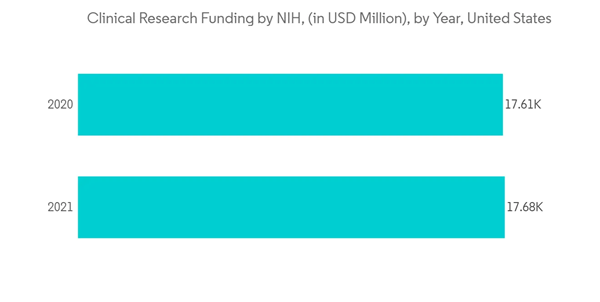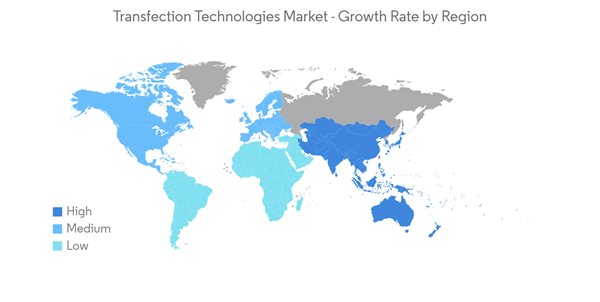The market for transfection technologies is expected to grow at a CAGR of about 9.1% over the next few years.
The COVID-19 pandemic had a significant impact on the market studied. There had been increasing research on coronavirus and its spread during the pandemic. Transfection, the process that enables the delivery of nucleic acids into cells to overexpress a protein of interest and/or inhibit gene expression, contributed significantly to the development of novel strategies to cope with COVID-19. Companies such as Polyplus supported COVID-19 research by providing innovative transfection reagents for gentle yet efficient delivery into cells. Owing to the movements of such companies, there was a high utilization of transfection technologies, which impacted the market positively. However, currently, the market is in its pre-pandemic state and is expected to witness healthy growth in the coming years.
The market is growing because of things like the rise in chronic diseases and the increase in research and development in the field of cell-based therapies.
According to the Centers for Disease Control and Prevention's March 2022 publication, six out of every ten adults in the United States have a chronic disease, and four out of every ten adults have two or more chronic diseases. Chronic diseases, such as cancer, chronic lung diseases, kidney diseases, arthritis, and many more, are the leading causes of death and disability and the leading drivers of the nation’s USD 4.1 trillion in annual healthcare costs. With the increasing burden of chronic diseases across the globe, there is a rising need for better therapeutics, for which various technologies have been developed. Transfection is one of the technologies that is being used largely to cope with chronic diseases. Since chronic diseases are so common, it is thought that the use of transfection technology will help the market grow in the coming years.
According to the American Cancer Society, the number of new cancer cases in the United States in 2021 is expected to be 1.9 million, with 608,570 cancer deaths.Since there are more and more people with chronic diseases like cancer, there will be more research into treatments for these diseases, which is thought to help the market grow.
But in the coming years, the growth of the market is likely to be slowed by the high cost of transfection technology instruments.
New launches in the area of reagent-based transfection technologies are augmenting segment growth. For instance, in August 2021, Polyplus launched a transfection reagent for large-scale viral vector production. Owing to the rising demand for viral vector production, the new launch from Polyplus can contribute significantly to easing the process of producing viral vectors. Hence, such new launches are expected to propel the segment's growth in the coming years.
Additionally, in August 2021, Mirus Bio, one of the leading companies in transfection technologies, launched viral vector transfection kits for cell and gene therapy manufacture. The company stated that transfection reagents were developed to enhance the delivery of packaging and transfer vector DNA to suspension to increase the production of recombinant adeno-associated virus (AAV) and lentivirus (LV) vectors.
Furthermore, there is increased funding for clinical research, which is a beneficial factor for segment growth. Clinical research is one of the crucial aspects of transfection technologies, which is expected to propel market growth.
Hence, owing to the increasing number of product launches in the segment, it is believed that the reagent-based method will witness significant growth during the forecast period.
The increasing burden of cancer among the US population is one of the leading factors responsible for market growth. For instance, as per the data from the American Cancer Society published in March 2022, the estimated total number of new cancer cases for the year 2022 is approximately 2 million. Among the cancer cases, breast cancer and cancers of the genital system are expected to have a high incidence. Transfection technologies are largely used in cancer therapeutics, which is believed to propel the growth of the market studied in the United States.
Furthermore, in May 2022, AGC Biologics added viral vector suspension technology and capacity for the development and manufacturing of gene therapies at its commercial-grade campus in Longmont, Colo. The new capabilities started coming online in the third quarter of 2022 and are complementing the site’s adherent viral vector and cell therapy offerings. With such an increasing focus on viral vector manufacturing, there will be a growing demand for transfection technology, which plays a crucial role in viral vector manufacturing.
Furthermore, according to National Health Institute estimates of funding for various research published in May 2022, gene therapy research funding in 2021 was USD 486 million, up from USD 403 million in 2020. The rise in funding will lead to increased adoption of viral vector manufacturing and transfection technologies in the United States, driving market growth in this region.
This product will be delivered within 2 business days.
The COVID-19 pandemic had a significant impact on the market studied. There had been increasing research on coronavirus and its spread during the pandemic. Transfection, the process that enables the delivery of nucleic acids into cells to overexpress a protein of interest and/or inhibit gene expression, contributed significantly to the development of novel strategies to cope with COVID-19. Companies such as Polyplus supported COVID-19 research by providing innovative transfection reagents for gentle yet efficient delivery into cells. Owing to the movements of such companies, there was a high utilization of transfection technologies, which impacted the market positively. However, currently, the market is in its pre-pandemic state and is expected to witness healthy growth in the coming years.
The market is growing because of things like the rise in chronic diseases and the increase in research and development in the field of cell-based therapies.
According to the Centers for Disease Control and Prevention's March 2022 publication, six out of every ten adults in the United States have a chronic disease, and four out of every ten adults have two or more chronic diseases. Chronic diseases, such as cancer, chronic lung diseases, kidney diseases, arthritis, and many more, are the leading causes of death and disability and the leading drivers of the nation’s USD 4.1 trillion in annual healthcare costs. With the increasing burden of chronic diseases across the globe, there is a rising need for better therapeutics, for which various technologies have been developed. Transfection is one of the technologies that is being used largely to cope with chronic diseases. Since chronic diseases are so common, it is thought that the use of transfection technology will help the market grow in the coming years.
According to the American Cancer Society, the number of new cancer cases in the United States in 2021 is expected to be 1.9 million, with 608,570 cancer deaths.Since there are more and more people with chronic diseases like cancer, there will be more research into treatments for these diseases, which is thought to help the market grow.
But in the coming years, the growth of the market is likely to be slowed by the high cost of transfection technology instruments.
Transfection Technologies Market Trends
Reagent-based Method is Showing Significant Growth in the Transfection Technologies Market
The reagent-based transfection technology market is experiencing significant growth owing to its cost-effectiveness and the less complicated methods involved during transfection. Likewise, the instrument-based method includes electroporation, biolistic technology, microinjection, and laserfection. Instrument-based methods are also less time-consuming and more accurate, and all these advantages drive the growth of this segment. Nucleic acids can be introduced into eukaryotic cells either unpurified or purified using transfection reagents. These products could consist of reagents, kits, primer sets, plasmids, and more.New launches in the area of reagent-based transfection technologies are augmenting segment growth. For instance, in August 2021, Polyplus launched a transfection reagent for large-scale viral vector production. Owing to the rising demand for viral vector production, the new launch from Polyplus can contribute significantly to easing the process of producing viral vectors. Hence, such new launches are expected to propel the segment's growth in the coming years.
Additionally, in August 2021, Mirus Bio, one of the leading companies in transfection technologies, launched viral vector transfection kits for cell and gene therapy manufacture. The company stated that transfection reagents were developed to enhance the delivery of packaging and transfer vector DNA to suspension to increase the production of recombinant adeno-associated virus (AAV) and lentivirus (LV) vectors.
Furthermore, there is increased funding for clinical research, which is a beneficial factor for segment growth. Clinical research is one of the crucial aspects of transfection technologies, which is expected to propel market growth.
Hence, owing to the increasing number of product launches in the segment, it is believed that the reagent-based method will witness significant growth during the forecast period.
North America is Expected to Witness a Healthy Growth in Coming Years
North America is expected to witness significant growth in the market, which is driven by factors such as increasing cases of chronic diseases such as cancer and the growing use of viral vectors, which require transfection methods to treat chronic diseases. The United States and Canada are the major consumers of transfection technologies in this region.The increasing burden of cancer among the US population is one of the leading factors responsible for market growth. For instance, as per the data from the American Cancer Society published in March 2022, the estimated total number of new cancer cases for the year 2022 is approximately 2 million. Among the cancer cases, breast cancer and cancers of the genital system are expected to have a high incidence. Transfection technologies are largely used in cancer therapeutics, which is believed to propel the growth of the market studied in the United States.
Furthermore, in May 2022, AGC Biologics added viral vector suspension technology and capacity for the development and manufacturing of gene therapies at its commercial-grade campus in Longmont, Colo. The new capabilities started coming online in the third quarter of 2022 and are complementing the site’s adherent viral vector and cell therapy offerings. With such an increasing focus on viral vector manufacturing, there will be a growing demand for transfection technology, which plays a crucial role in viral vector manufacturing.
Furthermore, according to National Health Institute estimates of funding for various research published in May 2022, gene therapy research funding in 2021 was USD 486 million, up from USD 403 million in 2020. The rise in funding will lead to increased adoption of viral vector manufacturing and transfection technologies in the United States, driving market growth in this region.
Transfection Technologies Market Competitor Analysis
The global market for transfection technologies is moderately competitive. International and local companies offer products for different types of transfection methods for pharmaceutical and biotechnology companies, contract research organizations (CROs), and academic and research institutes.Additional benefits of purchasing the report:
- The market estimate (ME) sheet in Excel format
- 3 months of analyst support
This product will be delivered within 2 business days.
Table of Contents
1 INTRODUCTION
4 MARKET DYNAMICS
5 MARKET SEGMENTATION
6 COMPETITIVE LANDSCAPE
Companies Mentioned (Partial List)
A selection of companies mentioned in this report includes, but is not limited to:
- Lonza Group
- Bio-Rad Laboratories, Inc.
- Thermo Fisher Scientific
- Qiagen NV
- Promega Corporation
- SignaGen Laboratories
- Merck KGaA
- Altogen Biosystems
- Polyplus-transfection SA
- Mirus Bio
Methodology

LOADING...










